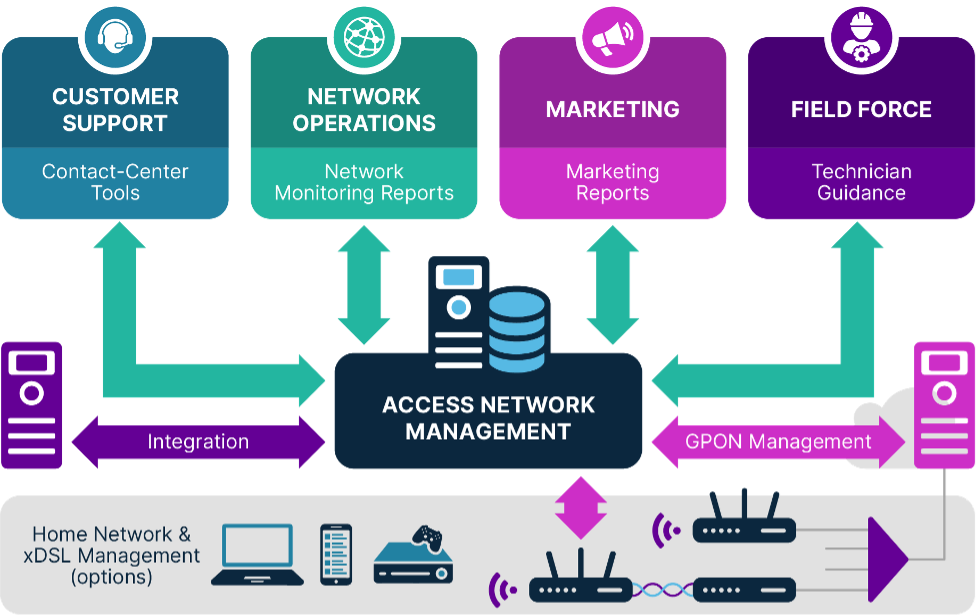As traditionally understood in our industry, when someone uses the term “dumb pipes” they are typically referencing a network that is only offering bandwidth and network feeds to subscribers, with no added differentiated value or add-on services to the end-customer.
In some circumstances, this is by design because of tight regulations that prohibit network providers from also providing end-user services. In other situations, the difficulty in providing connectivity in the service area is so challenged that all resources must be dedicated to basic services. However, in most circumstances where service providers are only delivering “dumb pipe” basic connectivity, it is because they are still viewing their subscribers through the lens of a traditional best-effort “telephone service” mentality where most subscribers are undifferentiated and investments in expanding services won’t provide a predicted satisfactory return-on-investment (ROI). The challenge to this line of thinking is that the competitive environment has changed in almost every network, and the opportunities to add new services and value have never been more within reach.
In a world where low-earth satellites and private equity funded overbuilders are making almost any market vulnerable to competition, all service providers – even in the most economically challenged markets – need to beware and act. The need to embrace an “experience” provider mindset that allows them to introduce value-added new services through market segmentation, personalization, or both has become a necessity. Failure to do so will likely result in rapid erosion of the “dumb pipe” provider subscriber base, resulting in a negative economics spiral where fewer and fewer subscribers will need to support the costs of operating the existing fixed network. The good news is that as service providers increasingly implement fiber-based infrastructure, these networks offer significant bandwidth upside potential and opportunities for data collection that can be used to turn “dumb pipes” into a “smart network” that can provide a superior and monetizable subscriber experience.
The Experience Provider Opportunity
Providing basic broadband connectivity to subscribers has proven be an essential service like electricity and water to the modern home and business, but unlike those services it offers enormous opportunity for enhancement. The problem with offering only “dumb pipes” is that it is usually a race to the bottom. With few options for increasing Average Revenue Per User (ARPU), reducing churn, and differentiating your brand through an exceptional subscriber experience, service providers are left trying to squeeze savings from operations. By competing solely on speeds and feeds, “dumb pipe” service providers are shackling their investments with limited returns and opening themselves up to subscriber losses.
 The solution to emerging from the “dumb pipe” conundrum lies in using the information passing back and forth through your access network between your subscribers’ premises and your central office to provide intelligent insights to better understand user behavior and preferences, both individually and collectively.
The solution to emerging from the “dumb pipe” conundrum lies in using the information passing back and forth through your access network between your subscribers’ premises and your central office to provide intelligent insights to better understand user behavior and preferences, both individually and collectively.
By applying the right analytics to those insights, service providers can upsell value-added services (e.g., a “gaming” and “work-from-home” packages) to increase ARPU. Further, they can improve service levels to reduce churn, gain new subscribers or recover lost ones and expand their services footprint.
Leveraging AI for Subscriber Insights
How can insights be wrung out of “dumb pipes”? One leading-edge method is to apply cloud-based Artificial Intelligence (AI) and machine learning (ML) capabilities to aggregate relevant data, then apply analytics to meet business/operational intelligence needs. These capabilities are proving transformational for service providers by empowering them to orchestrate and optimize popular services like subscriber WiFi experience management. The goal is to give service providers efficient and effective ways to differentiate their brand with unique services and superior customer support.
A Proven Approach
DZS’ approach, proven across tens of millions of connections globally, is to maximize the value of business and operational intelligence traveling across our customers’ access networks with two overlapping capabilities that can optionally display insights on a single dashboard:
- Access network assurance capabilities that work across multiple vendors’ equipment to monitor, identify, diagnose and fix subscribers’ connectivity issues leveraging AI-driven intelligent recommendations (DZS Expresse)
- End-to-end monitoring, management and proactive optimization of in-home WiFi networks utilizing contextual analytics and machine learning algorithms (DZS CloudCheck)

Going Above and Beyond
Moving beyond network assurance and WiFi experience optimization, service providers are also now leveraging network data insights to rapidly deliver transformational new services catered to their individual needs. This cutting-edge of cloud-based, AI-assisted technology is giving service providers the agility to roll out these new services rapidly and inexpensively at every step in the services lifecycle – from design through testing and deployment to orchestration and management. But in order to do so, it must be highly automated.
DZS Xtreme cloud software is a modern solution that makes rapid delivery of transformational new services possible for service providers. DZS Xtreme’s intent-based, low/no-code and model-driven architecture allows operators to create unified services across a multi-vendor access environment while slashing integration cycles from months or years down to weeks. The solution also ensures that any integrations with the service provider’s ecosystem of suppliers can be performed just once and can be reused for any subsequent service, reducing potential integration costs by millions of dollars.
Next Steps
Operators that rely on DZS cloud-based software solutions to deliver subscriber and operational intelligence view DZS as their analytics partner who is helping them deliver their end-customers superior communications experiences, and not just an access and software provider.
In fact, DZS recently won the 2023 Light Reading Leading Lights award in the Home Network Intelligence category for UK-based TalkTalk Group’s deployment of DZS’ AI-based Cloud Edge technology. Using DZS Expresse and DZS CloudCheck, TalkTalk is now able to leverage WiFi management and service assurance for end-to-end visibility into the customer experience, real-time insights and provide actionable intelligence. The deployment has resulted in significantly reduced call handling times, improved first-time service problem fix rates, reduced cost-to-serve, improved response times, lower customer churn and higher customer retention rates, which has led to improved Net Promotor Scores.
To discover how your organization can avoid the “dumb pipe” conundrum and leverage industry-leading managed WiFi and other analytics-powered services to differentiate your subscriber experience, contact DZS at dzsi.com/contact-us.



 '
'